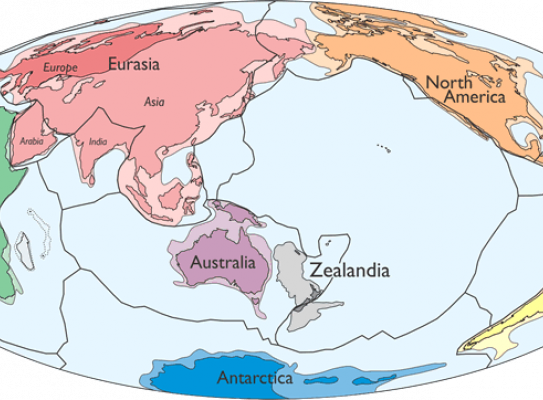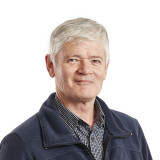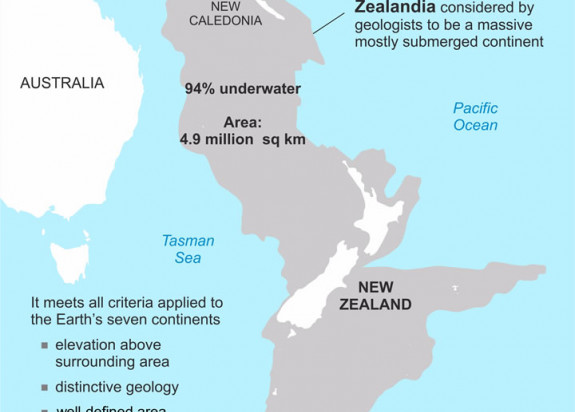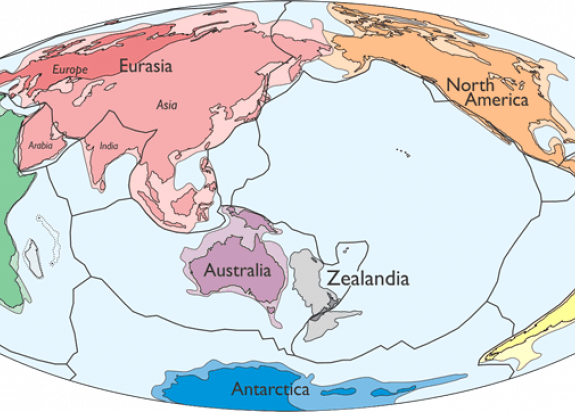New hidden continent mostly underwater, scientists say

New Zealand is not just a few small islands at the bottom of the world. It is actually part of a fairly large continent 94% of which is under the sea.
This is the conclusion of a paper published this week in GSA Today, the journal of the Geological Society of America.
Eight GNS Science geologists, along with colleagues from Victoria University, the Geological Survey of New Caledonia, and the University of Sydney summarise the evidence that 4.9 million square kilometres of the South West Pacific Ocean is underlain by a submerged continent.
This will not be a surprise to many New Zealand geoscientists, as GNS Science staff and colleagues have long been building the case for Zealandia and it has already been the subject of many books and presentations.
Lead author Nick Mortimer of GNS Science said this latest publication was significant in that it described the results of more than 20 years geology and geophysics research in a summary paper that is fully referenced and peer-reviewed.

Being more than 1 million square kilometers in area, and bounded by well-defined geologic and geographic limits, Zealandia is, by our definition, large enough to be termed a continent.
Zealandia has a continental crust thickness between 10km and 30km, and increasing to more than 40km under parts of the South Island.
"Based on various lines of geological and geophysical evidence, particularly those accumulated in the last two decades, we argue that Zealandia is not a collection of partly submerged continental fragments but is a coherent 4.9 square million kilometre continent."
"Currently used conventions and definitions of continental crust, continents, and microcontinents require no modification to accommodate Zealandia."
Zealandia is six times bigger than Madagascar, and about the same area as greater India.
As well as being the seventh largest geological continent, Zealandia is the youngest, thinnest and most submerged.

“Zealandia provides a fresh context in which to investigate processes of continental rifting, thinning, and breakup.”
The name Zealandia was first proposed by geophysicist Bruce Luyendyk in 1995 as a collective name for New Zealand, the Chatham Rise, Campbell Plateau, and Lord Howe Rise.
Zealandia illustrates that the large and obvious in natural science can be overlooked. Dr Mortimer said the authors hoped the new paper would be the ‘go to’ scientific reference on Zealandia for many years to come.
GSA Today has a global audience, and the presence of an extra continent on a map of the Earth will be a genuine surprise to many European, Asian, American, African and Australian geologists. GSA Today publishes 12 science articles per year.
In summary
Zealandia is the world's smallest and most submerged continent. Evidence for this has been building over many decades, but a recently published GSA Today paper is a benchmark. It is the first time all the various kinds of data and the defining features and limits of Zealandia have been described in a single scientific paper. The case is made that Zealandia is not just continental, but a continent.
Key points:
- 4.9 Mkm2 area
- 94% submerged (wide continental shelves)
- Highest point Aoraki-Mt Cook 3724m
- Two tectonic plates (Pacific, Australian)
- Was once part of the Gondwana supercontinent
Of the eleven authors on the paper, nine are from GNS Science. This reflects the convergence of many strands of long term and ongoing research projects and 'joining the dots' by staff in GNS Science's Regional Geology, Marine Geoscience, and Petroleum Geoscience departments. Especially influential have been the QMAP 1:250 000 national mapping programme, and research into New Zealand's basement terranes and batholiths, the marine geology of the Tasman Frontier region between New Zealand and New Caledonia, the Chatham Islands, and New Zealand's offshore sedimentary basins.
International colleagues have played an invaluable role in exploring and defining Zealandia. Collaborative voyages on the research vessels Tangaroa, Sonne, l'Atalante, Southern Surveyor and Investigator have probed Zealandia's crust and retrieved essential continental rock samples.

Ten things to know about Zealandia
On 10 Feb 2017 (New Zealand time), the Geological Society of America journal GSA Today published a peer-reviewed, open access science article online called Zealandia: Earth's Hidden Continent. The authors were nine GNS Science staff plus two colleagues from the Geological Survey of New Caledonia and the University of Sydney. The paper had taken many months to write and its origins went back many years to a mix of onland and offshore GNS Science research projects.
On 14 February, the Geological Society of America issued a one paragraph news release about the Zealandia paper. By 16 February articles started to appear in the world's media. In the following two weeks, news of Zealandia reached a potential worldwide audience of 900 million.
1. Is Zealandia really new?
Zealandia is not a new concept to many New Zealanders, so understandably many people will wonder what all the fuss is about. Earth scientists have been talking about Zealandia since the 1990s. The Penguin book Zealandia: Our Continent Revealed was published by Penguin NZ in 2014. And in 2015 there was a nationwide lecture tour about it. But for scientists, this was not enough. They needed a properly referenced, peer reviewed scientific paper on Zealandia. And now they have it.
2. Why all the global interest in Zealandia?
The science paper makes the statement ‘Zealandia illustrates that the large and the obvious in natural science can be overlooked’. This struck a chord with people who had never heard of Zealandia before. The concept of a hidden or drowned continent captures the imagination. And it's good to get a nice surprise rather than a nasty one. Many news stories have said that scientists 'discovered' Zealandia. That sounds epic, but it’s not really correct. Scientists been building up to the 'revealing' of Zealandia for a few years.
3. What is the scientific value of Zealandia?
The aim of publishing the science paper was to formally describe and define Zealandia, to show that it is simply a more correct and informative way to describe this part of the southwest Pacific Ocean. That alone is worth doing: a world map showing Zealandia is better than one that doesn't. The more interesting questions in science are not 'what' and 'where' but 'how' and 'why'. For people who study how and why continents break apart, deform and collide, Zealandia is potentially as useful as the Himalayas. It is the thinnest, most submerged and smallest continent, but is not completely shredded or broken into small pieces. Inevitably, Zealandia will be of use to other natural sciences. For the biological world, Zealandia provides a new and useful context of flora and fauna evolving on a continent whose landmass shrank, and sank beneath the waves. Geologists, geophysicists, zoologists, botanists, paleoclimate modellers and conservationists should all care about Zealandia.
4. Does it matter?
Some people have asked 'so what?'. What's changed? In some ways nothing has changed and in other ways everything has. The rocks and the ocean are still the same as they were before the paper, but now it's possible to look at this part of the planet in a new way. Names and labels are very powerful things in science and society.
5. You can’t see most of it – 94% is under water
Only 6 percent of Zealandia is above water and inhabitable. However, if you were to drain the oceans Zealandia would stand out as a well-defined high-standing plateau above the ocean floor.
6. How can Zealandia get formally recognised?
It can't. It's not like a mountain, country or planet. There is no formal body to approve a continent. If other scientists use Zealandia and cite the paper then that will be a validation of our work. But it will take time. We hope that Zealandia will eventually make its way onto general world maps, be taught in schools and become as familiar a name as Antarctica.
7. Does the identification of Zealandia have any territorial or political implications?
No. New Zealand and Australia agreed on their mutual maritime boundaries by treaty in 2004. These were subsequently ratified by the United Nations Commission on the Limits of the Continental Shelf in 2007. Both countries put a lot of survey work into their continental shelf projects at the time, and data from them was used and cited in the recent Zealandia paper. Put another way, the data and interpretations in the recent paper are entirely consistent with the work that established the basis of extended continental shelf territories.
8. What do you think about people that disagree that Zealandia is a continent?
It's fine and appropriate in science to have disagreement. Getting a paper published doesn't mean your ideas are right, just that they are worth putting to a wider group of scientists. Others may not be so convinced but we are. Confirmation will come if or when others cite the paper and use the name Zealandia themselves.
9. Shouldn't continents contain cratons, really old Precambrian rocks?
The definition of a continent shouldn't depend on time. If we were defining continents 1 billion years ago in the past, the Precambrian rocks would have been much younger. Rock types (granites, schists etc) are the best way to go. Continents are so much more than just cratons.
10. Proper continents are only land aren't they?
Not to geoscientists. Continents consist of both land masses and continental shelves. This is a better definition than just land because land areas change drastically during ice ages when sea levels rise and fall. If people accept that continents don't stop at the low water mark but carry on across continental shelves, then the case for Zealandia is understood.